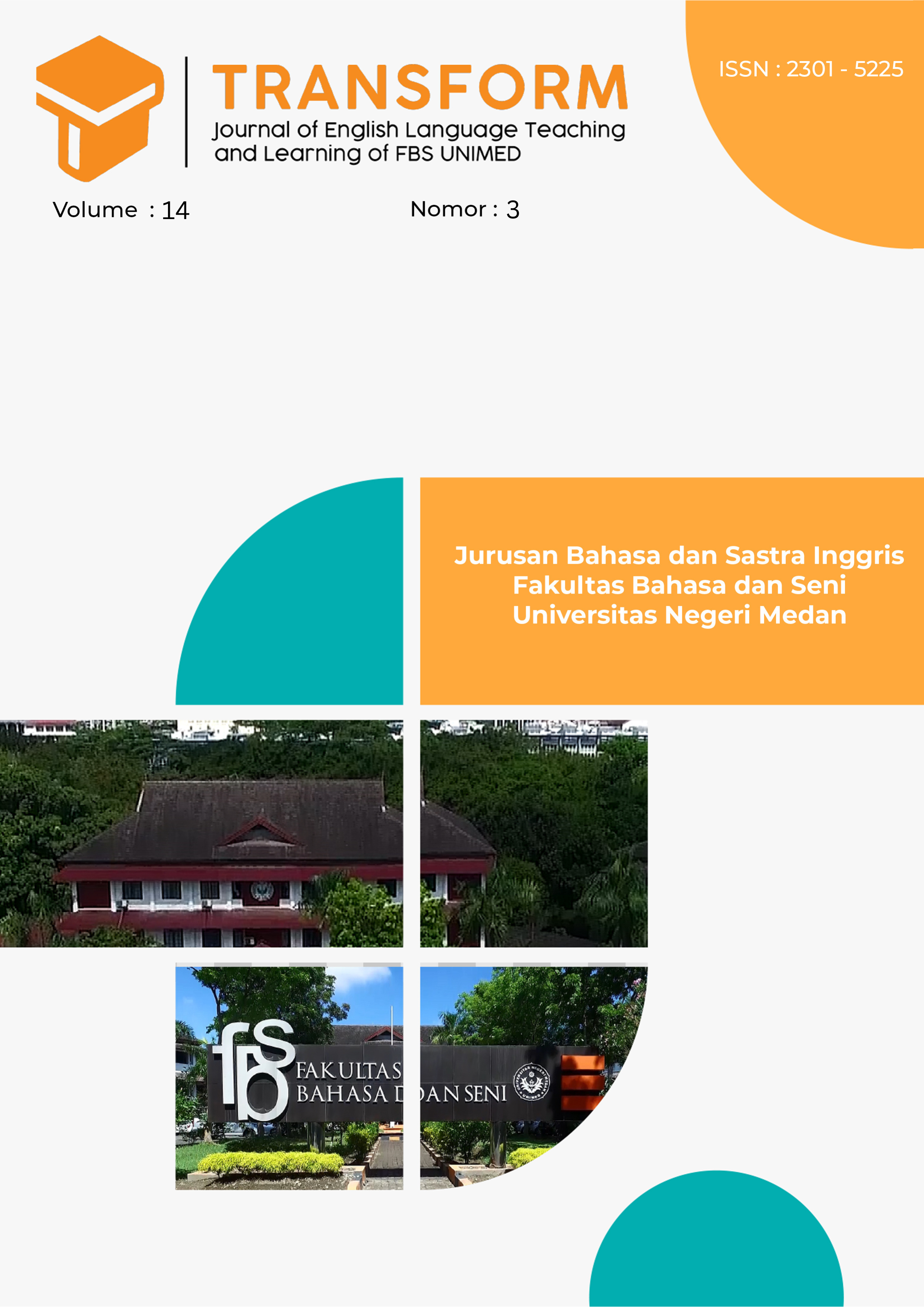Teacher's Translanguaging Practice in EFL Classroom Interaction in A Junior High School
DOI:
https://doi.org/10.24114/tj.v14i3.68751Keywords:
Translanguaging, Classroom Interaction, English Language TeachingAbstract
This research intends to examine the teacher’s translanguaging practices in EFL classroom interaction at a junior high school setting. A qualitative research approach was adopted. The data gathered through observation and interviews. The participant in this study was a seventh-grade English teacher from SMP Negeri 5 Percut Sei Tuan. The findings revealed that the teacher utilized four types of translanguaging practices: (1) translanguaging within one named language (Indonesian), (2) translanguaging through translation, (3) translanguaging through peer support, and (4) translanguaging through two named languages (Indonesian and English). These practices were employed to deliver instructions, clarify learning materials, and ensure students’ understanding. The reasons for using translanguaging included students’ limited vocabulary mastery, the need to clarify teacher instructions and the creation of a comfortable learning environment. The study concludes that translanguaging is an effective pedagogical strategy for enhancing student comprehension and supporting the teaching-learning process of English as a foreign language.References
Baker, C. (2001). Foundation of Bilingual Education and Bilingualism: 3rd Edition. Multilingual Matters Ltd
Beres, A. M. (2015). An Overview of Translanguaging: 20 years of ‘Giving Voice to Those Who do not Speak.’ Translation and Translanguaging in Multilingual Contexts, 1(1), 103-118.
Cummins, J. (2014). Rethinking Pedagogical Assumptions in Canadian French Immersion Programs. Journal of Immersion and Content-Based Language Education, 2(1), 3-22.
García, O., & Wei, L. (2014). Translanguaging: Language, Bilingualism and Education. Basingstoke: Palgrave Macmillan.
Iversen, J. Y. (2019). Pre-service teachers’ translanguaging during field placement in multilingual, mainstream classrooms in Norway. Language and Education, 34(1), 51-56. DOI: 10.1080/09500782.2019.1682599
Nayar, B. (1997). ESL/EFL Dichotomy Today: Language Politics or Pragmatics? TESOL Quarterly, 31(1), 9-37.
Ng, L. L., & Lee, S. L. (2019). Translanguaging Practices and Identity Construction of Multilingual Malaysian University Graduates in Digital Media. English Teaching & Learning, 43(1), 105-123.
Puspitasari, P. T., and Sugirin. (2024). Translanguaging used in speaking class of non-formal education program: students’ and teachers’ perception. International Journal of Contemporary Studies in Education, 3(1), 13-21.
Raja, D. F., Suparno, S., & Ngadiso, N. (2022). Students’ attitude towards translanguaging practice in Indonesian EFL classes. Al-Ishlah: Jurnal Pendidikan, 14(1), 979-988.
Siregar, M. (2020). Translanguaging Used by English Teacher at Vocational Schools Medan. Budapest International Research and Critics in Linguistics and Education (BirLE) Journal, 3(2), 1259-1266.
Vogel, S., & Garcia, O. (2017). Translanguaging: Languages and literacies. Oxford Research Encyclopedia of Education. DOI: 10.1093/acrefore/9780190264093.013.181
Yuvayapan, F. (2019). Translanguaging in EFL Classrooms: Teacher’s Perceptions and Practices. Journal of Language and Linguistic Studies, 15(2), 678-694.
Downloads
Published
How to Cite
Issue
Section
License
Copyright (c) 2025 Cindy Luasen Pakpahan

This work is licensed under a Creative Commons Attribution-ShareAlike 4.0 International License.
Authors who publish with this journal agree with the following terms:
- Authors retain copyright and grant the journal right of first publication with the work simultaneously licensed under a Creative Commons Attribution License that allows others to share the work with an acknowledgment of the work's authorship and initial publication in this journal.
- Authors are able to enter into separate, additional contractual arrangements for the non-exclusive distribution of the journal's published version of the work (e.g., post it to an institutional repository or publish it in a book), with an acknowledgment of its initial publication in this journal.
- Authors are permitted and encouraged to post their work online (e.g., in institutional repositories or on their website) prior to and during the submission process, as it can lead to productive exchanges, as well as earlier and greater citation of published work (See The Effect of Open Access).
- This work is licensed under a Creative Commons Attribution-ShareAlike 4.0 International License.








